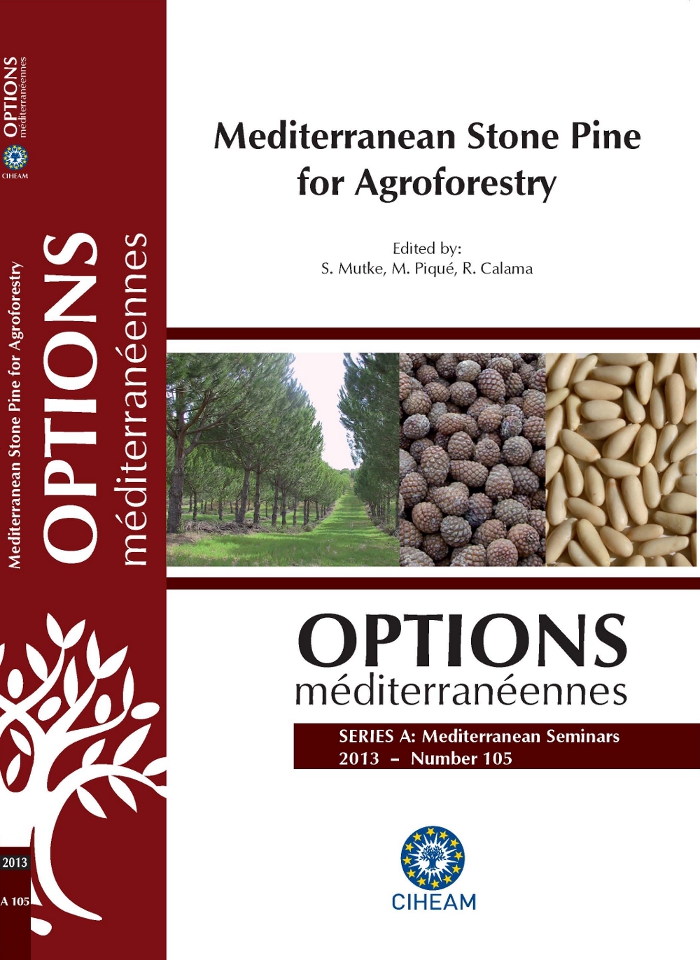| Article précédent | p. 35-41 | Article suivant |
Cone yield evaluation of a grafted Pinus pinea L. trial
Grafted stone pine plantations for cone production could be an interesting alternative on low quality agriculture lands, as they display various advantages compared to the traditional forest harvesting: the possibility to use more productive genotypes, early bearing, easily harvesting, etc. Some grafted experiences with P. pinea have already been done, mainly focused on elucidating the relevance of environmental factors and in the selection of the best productive genotypes; however the productive information is still scanty. With a view to go into the species´ agronomical potential knowledge in depth, in 2008 a grafted trial was planted at IRTA’s Torre Marimon station (Caldes de Montbui, Spain). In 2010 an irrigation essay was started in order to study the effect of different water regimes on the strobili induction and productive responses. The first results show an early production onset on production, from barely 50 flowers/ha in 2008 to more than 3,500 in 2011. The first significant cone yield was registered in 2011, with 840 kg•ha-1. Concerning water supply, preliminary results show in the irrigated trees a lower fruit mortality on the second development year than in the control (7% against 20%, in 2010) and a higher floral induction (14 flowers/tree against 10, in 2011) . Further results in the coming years will allow to evaluate the productive potential of this kind of plantations.
Les plantations greffées de Pinus pinea peuvent constituer une intéressante alternative pour les terrains agricoles de basse qualité car présentant divers avantages en comparaison à la gestion forestière traditionnelle : possibilité d’utiliser des génotypes plus productifs, rapide entrée en production, facilité de récolte, etc. Diverses expériences de P. pinea greffé ont été déjà faites, principalement orientées à déterminer l’importance des facteurs environnementaux et à sélectionner des génotypes plus productifs. Cependant, l’information productive est plutôt rare. Afin d’approfondir les connaissances sur le potentiel agronomique de l’espèce, une plantation de P. pinea greffé fut établie en 2008 à l’IRTA Torre Marimon (Caldes de Montbui, Espagne). En 2010 un essai d’irrigation démarra dans l’objectif d’étudier l’effet de différents régimes hydriques pour l’induction florale et la réponse productive. Les premiers résultats montrent une rapide entrée en production, passant de 50 fleurs/ha en 2008 jusqu’à plus de 3500 en 2011. La première production significative de cônes eut lieu en 2011, avec 840 kg/ha. Concernant l’apport hydrique, les résultats préliminaires montrent une plus faible mortalité des cônes de deuxième année (7% versus 20%, en 2010) et une plus nombreuse induction florale (14 fleurs/arbre versus 10, en 2011) des arbres irrigués par rapport aux arbres témoins. Le suivi de cette expérience permettra d’évaluer plus précisément le potentiel productif de ce type de plantations.
- [ Afficher ]
- [ Télécharger ]
- [ Exporter la citation ]
Vous pouvez télécharger la citation au format :
- [ Imprimer ]
-
Mots-clés
AGROFORESTERIE, FACTEUR DE RENDEMENT, INTERACTION GENOTYPE ENVIRONNEMENT, IRRIGATION, PINUS PINEA, PLANTATION FORESTIERE, CONECiter cet article
Bono D., Aletà N. Cone yield evaluation of a grafted Pinus pinea L. trial. In : Mutke S. (ed.), Piqué M. (ed.), Calama R. (ed.). Mediterranean stone pine for agroforestry. Zaragoza : CIHEAM / FAO / INIA / IRTA / CESEFOR / CTFC, 2013. p. 35-41. (Options Méditerranéennes : Série A. Séminaires Méditerranéens; n. 105). AGROPINE 2011 International Meeting on Mediterranean Stone Pine for Agroforestery, 2011/11/17-19, Valladolid (Spain). http://om.ciheam.org/om/pdf/a105/00006779.pdf



